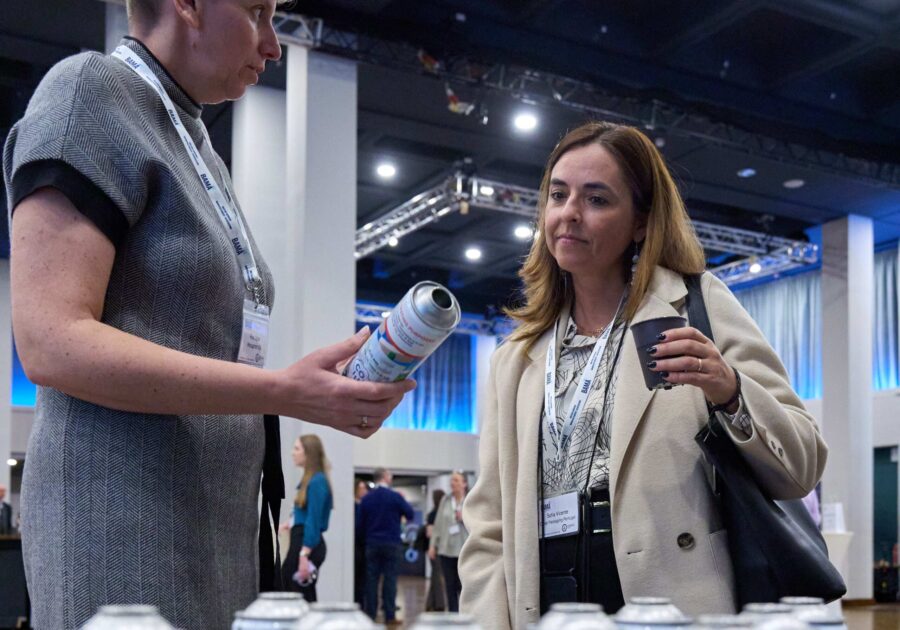Mapping out a successful future

BAMA’s exhibition hall provided plenty of networking opportunities. Image: BAMA
Alex Rivers reports on the 2025 edition of the British Aerosol Manufacturers Association (BAMA) Innovation Day.
Learning from the past and navigating future challenges were common themes throughout BAMA’s 2025 Innovation Day – which took place on 23 April – along with where technology could lead the industry.
The association’s chief executive, Patrick Heskins, kicked off the conference by sharing ChatGPT responses to the question ‘where will aerosol dispensing be in 2035?’ Among the replies from the artificial intelligence chatbot were sleek minimalist design, refillable solutions and AI powered customisation.
Olga Munroe, head of The Retail Institute, began her presentation by asking the audience to choose a word to define what the future looks like generally. The two words chosen were “chaos” and “uncertain,” which Munroe agreed with. She explained how it pays to be prepared for future challenges sometimes by even thinking of the worst case scenario.
The Retail Institute recently undertook an initiative along with BAMA, other trade associations, brand owners and corporations in the packaging sector to map potential future problems associated with sustainable packaging. Key takeaways from the companies involved in the collaborative project, said Munroe, included the need for greater supply chain harmonisation; eliminating/avoiding greenwashing in communication; providing continuous learning to upskill employees; and collaboration between companies to help tackle sorting and waste issues.
Dr Henry Irving, senior lecturer in public history at Leeds Beckett University (home of The Retail Institute), began his presentation on waste reduction by stating “We are in a really important moment in history,” noting all the pending packaging reforms including DRS and EPR. Since we were located in the Leeds Royal Armouries Museum, and Irving’s specialist interest is in the Second World War, he used two war-related lessons from history centring around aluminium to illustrate some of the challenges involved in reducing waste. One of these was a campaign aimed at households separating their aluminium for the purpose of using the aluminium to build aircrafts. The campaigned gained initial popularity but the public became sceptical due to the suspicion around propaganda at the time.
Irving also showed the audience records from a 1942 diary by a waste collector in Wiltshire, who petitioned the government to help with the overfill his place of work was experiencing. It took the government a painstaking five months to take action due to the sheer volume of excess waste and lack of a rudimentary method to solve the problem. “A simple mechanism for waste sorting and collection is the most necessary first step to success,” Irving concluded.

Trinity College Dublin’s Barry Keane explores AI’s evolution. Image: AlexR/Bell Publishing
Barry Keane, researcher from Trinity College Dublin, also used examples from the past in his presentation, stating that computer scientist and mathematician Alan Turing’s work during WWII and into the 1950s laid the foundational concept of AI as we know it today. Keane added that AI becoming rule-based drove its acceleration and mass adoption. Echoing back to Munroe’s ‘future of uncertainty,’ Keane said that no matter how we view AI, we are already using it and have been using it “even if we weren’t aware.” Its role in manufacturing will take the aerosol industry to new heights if implemented correctly, he said, before calling for businesses to trial Trinity College Dublin’s ‘Humans-in-the-Loop’ (H-Loop) cloudbased system. H-Loop uses the feedback of machine operators to train on-the-fly (without using any pre-collected dataset) and in real-time an AI-model that can predict when the manufacturing process is good/bad, and then optimise it.
On the topic of refillable solutions, Respray founders, Andor Réti and Gergely Zámbó, provided the audience with an update on their innovation’s development since their last appearance at the BAMA Innovation Day conference in 2023. The company’s aerosol refill stations now total 30 in Hungary, with future plans to scale up operations in Germany and the US. Réti and Zámbó shared that since Respray’s launch, they have seen a 30% refill rate, meaning that every second transaction was already a refill of a personal care product from the consumer.
Elsewhere during the Innovation Day, technical presentations came from Alloway‘s Dr Michael McCullough, who explored his company’s latest developments in aerosol inspection solutions, and from DH Industries managing director, Paul Sullivan, who explored the role of CO2 as a gas propellant, noting important considerations in the handling and filling process. BAMA’s technical manager, Peter Watmough, then ended the day with news from the Association that its training has now been upgraded to include additional levels of learning, with each level requiring the user to pass an assessment via a series of questions about the four units provided (regulations, flammability, transportation and labelling of aerosols). Filling figures & UK aerosol sales Released a couple of days before the event were BAMA’s 2024 aerosol filling figures, which showed a solid year for the UK aerosol dispensing filling sector, with an increase of almost 2% over 2023, showing a return to growth.
The standout sector which makes up 75% of the total market is personal care, with an overall increase of 3% from 2023. With a 2.9% growth in deodorants, a 5% increase in antiperspirants and tanning and suncare rising by 22.5%, growth is evident across a number of categories. For the first time in recent years, shaving preparations have also grown, indicating a possible turning of the tide for the category.
In contrast, household product numbers have slowed compared to 2023, reinforced by a drop in the filling of air fresheners, as other formats for dispensing fragrance in the home continue to grow, and, as more of the furniture consumers have in the home is produced from manmade materials, furniture polish filling has also been impacted.
Some of the smaller categories showed significant growth, with medical aerosol products up by over 5% and insecticides by nearly 27%. Also, the number of oven cleaners filled more than doubled, and, the miscellaneous category, which includes products such as glitter sprays and temporary hair colours, showed phenomenal growth.
The numbers, which are supplied by UK fillers, indicate that aerosol dispensers continue to be a strong export product, with nearly 70% of the products made in the UK going to the EU (approximately 50% of production), and elsewhere in the world.
In addition to filling data, BAMA also released aerosol sales figures supplied by Kantar World Panel. The numbers represent retail sales of aerosol products within the personal care and household sectors, purchased in the UK between 2015 and 2024.
With a drop in body spray purchases, the data reveals signs of a ‘trade up’ to deodorants as a larger variety of antiperspirants have become more readily available to consumers since 2015.
Mirroring increased filling figures, suncare products also rose from 1,342 units in 2015 to 5,322 units in 2024. The ongoing decline in haircare aerosol sales may reflect shifts in fashion which, unlike other decades have not necessitated more styling products for women’s hair. For more information on the aerosol filling and retail sales data, turn the page.






